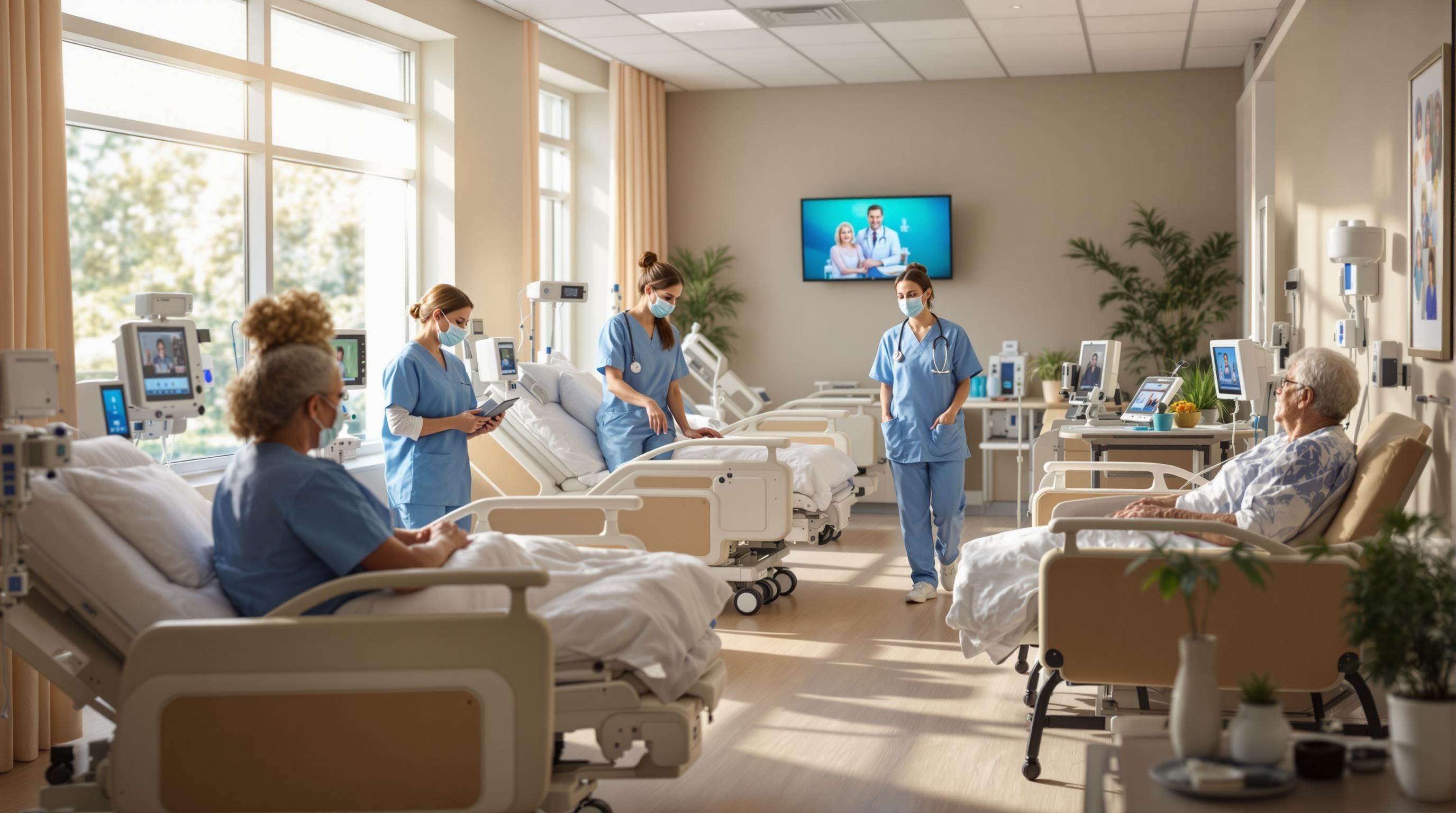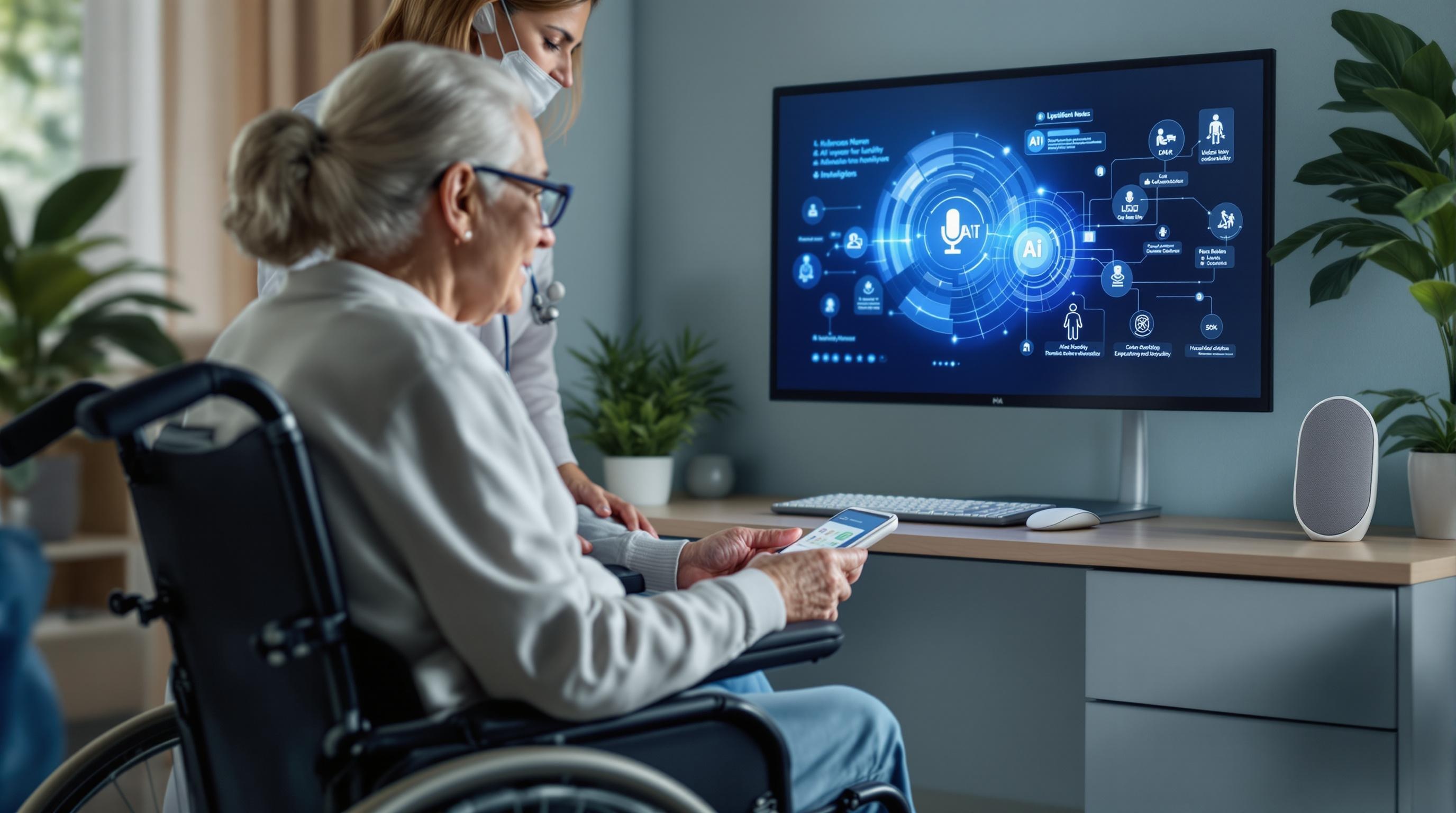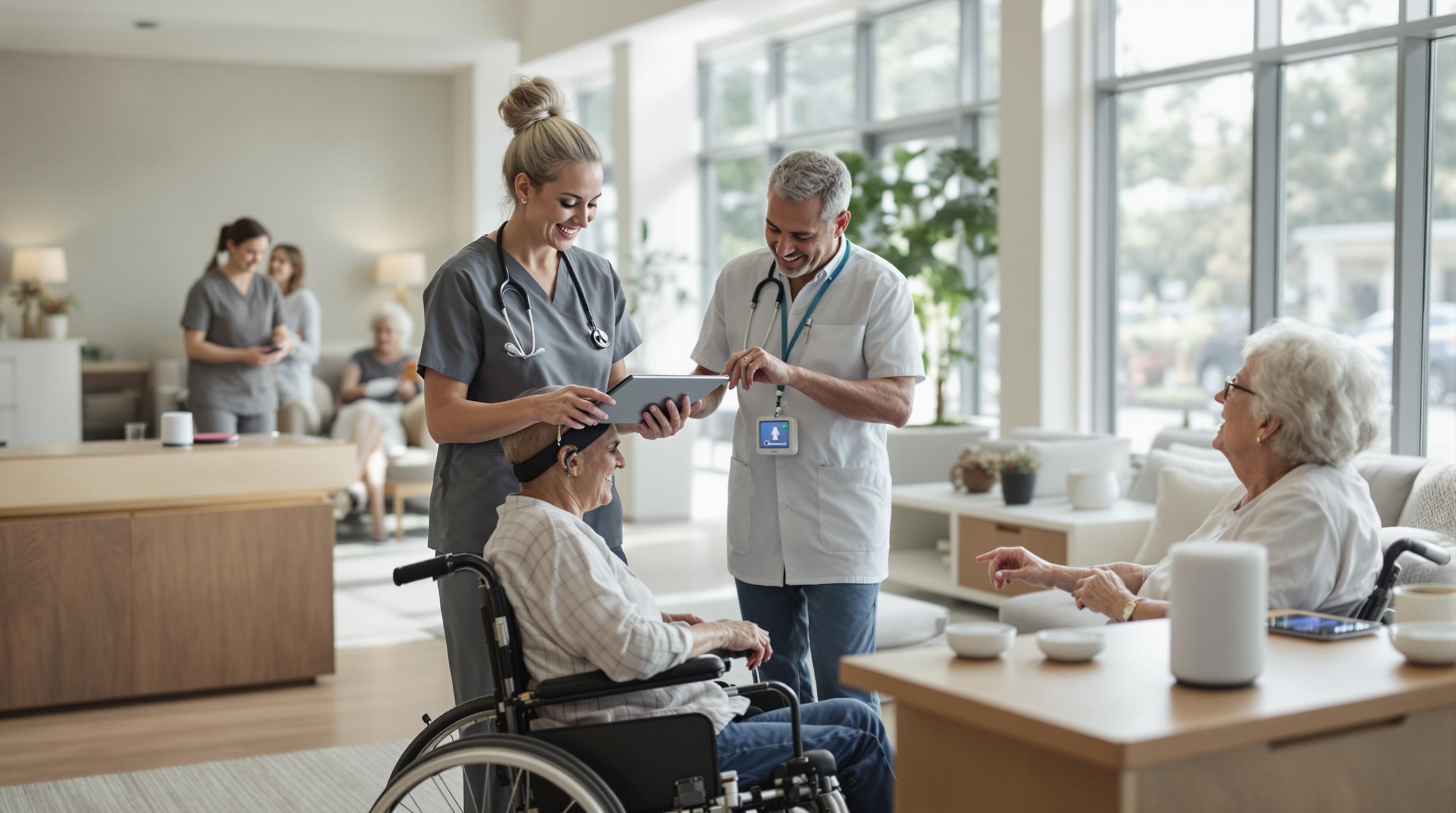Skilled Nursing Technology in New York: 2024 Trends & Solutions
Discover how skilled nursing technology is transforming New York facilities. Explore top innovations, benefits, and future trends for better patient care.
Quick Navigation
- 1. Introduction
- 2. Current Challenges in Skilled Nursing Technology New York
- 3. How Sparkco AI Transforms Skilled Nursing Technology New York
- 4. Measurable Benefits and ROI
- 5. Implementation Best Practices
- 6. Real-World Examples
- 7. The Future of Skilled Nursing Technology New York
- 8. Conclusion & Call to Action
1. Introduction
In 2024, New York’s skilled nursing facilities are at a crossroads—navigating an industry landscape defined by both challenge and opportunity. Despite the sector still contending with chronic staffing shortages—nearly 240,000 nursing home employees have exited the workforce nationwide since the pandemic—there’s a silver lining: technology is rapidly reshaping how care is delivered, managed, and experienced. From advanced electronic health records to telehealth and AI-powered monitoring, innovative solutions are quickly moving from “nice-to-have” to “must-have” for facilities determined to thrive in an evolving healthcare ecosystem.
Yet, the path forward isn’t without obstacles. Rising operational costs, regulatory uncertainty, and shifting reimbursement models are placing mounting pressure on facility leaders to do more with less. As New York’s skilled nursing sector strives to recover occupancy rates and maintain high standards of care, the integration of cutting-edge technology has become essential—not only to streamline clinical workflows but also to enhance resident outcomes and staff satisfaction.
In this article, we’ll explore the latest trends in skilled nursing technology across New York, spotlighting how forward-thinking facilities are leveraging digital tools to overcome persistent challenges. We’ll examine real-world examples of technology adoption, discuss the impact on staff efficiency and patient care, and highlight future innovations shaping the sector. Whether you’re an administrator, clinician, or industry observer, discover how technology is paving the way for a stronger, more resilient skilled nursing landscape in New York.
2. Current Challenges in Skilled Nursing Technology New York
The integration of advanced technology in skilled nursing facilities (SNFs) across New York is reshaping patient care, operations, and compliance. However, despite the promise of improved outcomes, many healthcare providers encounter significant obstacles. Below are the most pressing challenges facing SNFs as they adopt and optimize skilled nursing technology in New York.
- Interoperability Issues: Many New York SNFs struggle with electronic health record (EHR) systems that do not seamlessly connect with those used by hospitals, labs, and other providers. According to a New York State Department of Health report, only 56% of SNFs reported EHR interoperability with external partners in 2023. This fragmentation hampers care coordination and can lead to errors or delays in treatment.
- High Implementation and Maintenance Costs: Upgrading to state-of-the-art technology requires significant investment. The American Health Care Association (AHCA) notes that 67% of SNF administrators in New York cite budget constraints as a top barrier to adopting new tech, affecting both large urban and smaller rural facilities.
- Workforce Training Gaps: Effective use of skilled nursing technology depends on a well-trained staff. Yet, a LeadingAge New York survey found 74% of SNFs reported difficulty providing adequate tech training due to high staff turnover and limited resources, which impacts the quality of patient care and increases the risk of documentation errors.
- Complex Regulatory Compliance: New York’s skilled nursing facilities must comply with stringent federal and state regulations regarding electronic documentation, privacy (HIPAA), and telehealth. In 2023, 48% of SNFs reported at least one technology-related compliance deficiency during state inspections (source), risking fines and jeopardizing facility reputations.
- Cybersecurity Threats: The healthcare sector is a prime target for cyberattacks. In 2023, healthcare data breaches increased by 18% in New York, with skilled nursing facilities especially vulnerable due to legacy systems and limited IT resources (HIPAA Journal). Breaches not only disrupt operations but can compromise sensitive patient data.
- Limited Broadband and Infrastructure in Rural Areas: Especially upstate, many facilities struggle with poor internet connectivity, impeding the use of telehealth, remote monitoring, and cloud-based solutions. The New York State Senate found that 39% of rural SNFs lack adequate broadband, widening the digital divide and impacting patient access to timely care.
- Resistance to Change: Technological adoption often meets resistance from both staff and leadership accustomed to traditional workflows. This cultural barrier slows implementation and reduces the ROI of investments in new systems.
These challenges collectively hinder operational efficiency, increase the risk of non-compliance, and ultimately impact patient outcomes. Addressing these pain points requires collaborative efforts among policymakers, technology vendors, and facility leaders to ensure that investments in skilled nursing technology translate into better care for New Yorkers.
3. How Sparkco AI Transforms Skilled Nursing Technology New York
Skilled nursing facilities in New York face unique challenges, from regulatory compliance and staffing shortages to data management and patient care coordination. Sparkco AI is designed to directly address these hurdles, leveraging advanced artificial intelligence and automation to streamline operations and improve outcomes. Here’s how Sparkco AI is transforming skilled nursing technology in New York with practical, easy-to-understand solutions.
-
Automated Documentation and Compliance
Sparkco AI simplifies the tedious process of documentation by automatically capturing and organizing clinical notes, care plans, and compliance records. This ensures facilities stay up-to-date with New York’s rigorous regulatory requirements, reducing the risk of errors and costly penalties. By automating these tasks, staff can spend more time caring for residents rather than paperwork. -
Smart Staffing and Scheduling
Staffing shortages are a persistent issue in New York skilled nursing facilities. Sparkco AI uses predictive analytics to optimize staff scheduling based on resident acuity, census changes, and historical patterns. This ensures that the right number of caregivers are always available, minimizing overtime and burnout without compromising care quality. -
Real-Time Patient Monitoring
Sparkco AI integrates with existing medical devices and electronic health records, enabling real-time monitoring of vital signs and early detection of health risks. Automated alerts notify staff of any concerning changes, allowing for immediate intervention and reducing hospital readmissions. -
Streamlined Communication and Care Coordination
Effective communication between nurses, physicians, and families is critical in skilled nursing. Sparkco AI offers secure messaging and automated updates that keep everyone in the loop. Care teams can collaborate easily, share updates, and respond quickly to resident needs, leading to better care continuity and satisfaction. -
Data-Driven Insights for Quality Improvement
Sparkco AI collects and analyzes facility-wide data, generating actionable insights on care outcomes, operational efficiency, and regulatory trends. Administrators can use these insights to make informed decisions, implement targeted improvements, and track progress over time. -
Seamless Integration with Existing Systems
Sparkco AI is built to integrate smoothly with major electronic health record (EHR) platforms and other healthcare software used by New York skilled nursing facilities. The platform connects data across multiple systems, eliminating silos and ensuring a unified view of each resident’s care journey. This interoperability streamlines workflows and maximizes technology investments.
With its intuitive interface and robust integration capabilities, Sparkco AI empowers skilled nursing facilities in New York to tackle their toughest technology challenges head-on. By automating routine tasks, improving staffing efficiency, enabling real-time monitoring, and unifying data, Sparkco AI delivers measurable improvements in care quality, compliance, and operational performance.
4. Measurable Benefits and ROI
The adoption of automated skilled nursing technology in New York facilities is transforming the delivery of care and operational efficiency. Leveraging electronic health records (EHR), automated scheduling, and smart medication management systems, skilled nursing facilities (SNFs) are realizing significant returns on investment (ROI) and measurable improvements across multiple domains. Below, we outline key data-driven benefits, supported by industry studies and real-world case examples.
-
Time Savings on Documentation (Up to 60%)
Automated EHR and documentation systems reduce the time nurses spend on paperwork by up to 60% (HealthIT.gov). In a typical New York SNF, this equates to over 2.5 hours saved per nurse, per shift, allowing staff to focus more on direct patient care. -
Cost Reduction (Average $300,000 Annually per Facility)
According to a study published in JAMDA, skilled nursing facilities implementing automated care coordination and billing systems report average annual savings of $300,000 due to reduced overtime, lower administrative burden, and fewer billing errors. -
Reduction in Medication Errors (Up to 50%)
Automated medication dispensing and eMAR systems can decrease medication administration errors by up to 50% (NCBI study), improving patient safety and reducing adverse event costs. -
Improved Regulatory Compliance (Survey Deficiency Reduction by 45%)
Facilities utilizing automated compliance tracking tools report a 45% reduction in survey deficiencies, according to LeadingAge. This minimizes penalties and enhances facility reputation. -
Faster Reimbursement Cycles (Reduction by 30 Days)
Automated billing and documentation streamline claims processing, reducing reimbursement times by an average of 30 days (PointClickCare Case Studies), which significantly improves cash flow for New York SNFs. -
Decreased Readmission Rates (10-15% Improvement)
Facilities leveraging health information exchange (HIE) and automated care plans have seen 10-15% reductions in hospital readmission rates (HealthIT.gov), supporting value-based care initiatives and boosting reimbursement rates. -
Staff Retention and Satisfaction
With automation reducing administrative burnout, facilities report up to a 20% increase in staff retention and job satisfaction (McKnight’s Long-Term Care News), helping address workforce shortages prevalent in New York. -
Enhanced Patient Outcomes and Family Satisfaction
According to PointClickCare case studies, facilities using automated care coordination technologies report higher patient satisfaction scores and improved quality ratings on CMS’s Nursing Home Compare.
Automated skilled nursing technology offers a compelling ROI for New York facilities, delivering quantifiable benefits in efficiency, compliance, cost control, and care quality. As the regulatory and reimbursement landscape grows more complex, investing in automation is not only a competitive advantage but a necessity for sustainable, high-quality skilled nursing care.
5. Implementation Best Practices
Successfully implementing skilled nursing technology in New York requires a structured approach that addresses regulatory requirements, staff readiness, resident needs, and ongoing support. Follow these actionable steps to ensure a smooth and effective technology rollout in your skilled nursing facility.
-
Conduct a Needs Assessment
Evaluate your facility’s current workflows, regulatory mandates (such as those from NYSDOH and CMS), and resident care goals. Involve department heads and frontline staff to identify gaps where technology can have the greatest impact.
Tip: Survey staff and analyze incident reports or resident feedback for insights.
Pitfall: Implementing technology without understanding actual facility needs may result in low adoption and wasted investment. -
Engage Key Stakeholders Early
Assemble a multidisciplinary team—including nursing, IT, compliance, and resident representatives—to provide input and champion the project.
Tip: Assign clear roles and responsibilities to maintain accountability.
Pitfall: Excluding frontline staff can lead to resistance and overlooked workflow challenges. -
Choose Technology Aligned with NY Regulations
Ensure the technology solution meets both federal (CMS, HIPAA) and New York State (NYSDOH) requirements, including clinical documentation, data security, and resident rights.
Tip: Request vendor documentation on regulatory compliance and seek peer references from other NY facilities.
Pitfall: Overlooking local regulatory nuances can lead to costly compliance issues. -
Develop a Comprehensive Implementation Plan
Set specific, measurable milestones and timelines. Plan for data migration, pilot testing, and phased rollouts to minimize disruptions.
Tip: Use project management tools to track progress and adjust as needed.
Pitfall: A vague or unrealistic plan can cause delays and staff frustration. -
Provide Robust Staff Training and Support
Offer hands-on training tailored to different staff roles, and reinforce with refresher sessions. Establish a help desk or “super user” program for ongoing support.
Tip: Use real-world scenarios relevant to your facility during training.
Pitfall: Insufficient training increases errors and reduces technology ROI. -
Communicate Transparently Throughout the Process
Regularly update staff and residents about the project’s goals, benefits, and progress. Address concerns promptly to build trust and engagement.
Tip: Use newsletters, town halls, or digital dashboards to keep communication flowing.
Pitfall: Poor communication can fuel rumors and undermine change management efforts. -
Monitor, Evaluate, and Adapt
Track key performance indicators (KPIs) such as user adoption rates, documentation accuracy, and resident outcomes. Solicit feedback and be prepared to adjust workflows or provide additional training as needed.
Tip: Schedule regular reviews with your implementation team to address challenges and celebrate wins.
Pitfall: Failing to monitor results can allow










